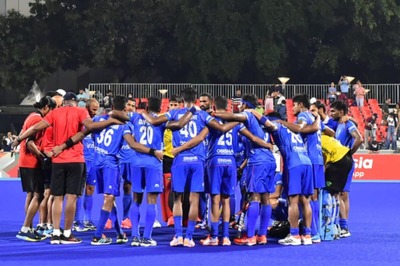
views
New Delhi: Traditional political understanding suggests that a political party’s performance early on in a multi-phased election holds significant importance in India. A good start can potentially uplift the ground-level party worker, which may result in attracting voters in the later phases and vice versa.
With 95 seats across 11 states and Union Territories going to polls in the second phase of elections on Thursday, fate of more than one-third of the total Lok Sabha seats will be sealed after just first two phases. Hence, the importance of the starting-line advantage remains further amplified.
In Uttar Pradesh, the politically crucial state which will vote in all seven phases this election season and eight seats in the Western region will be up for grabs in the second phase. These seats are: Agra, Aligarh, Amroha, Bulandshahr, Fatehpur Sikri, Hathras, Mathura, and Nagina. Four of these are reserved for the Scheduled Castes (SC). Earlier, eight seats had gone to polls in the first phase.
Much like the eight constituencies in the first phase, the eight seats in the second one also returned a Bharatiya Janata Party (BJP) legislator in 2014. This was a massive improvement from the 2009 tally when it had managed to win only one of these seats. However, on the basis of consistency, the BJP has remained the most dominant force in these seats since 1996. The year 1996, in this case, was taken for the sake of uniformity as Samajwadi Party (SP) first contested in that year.
On an average, the BJP has had a 36 per cent vote share over the last six Lok Sabha elections, beginning from 1996 and compared with SP’s 23 per cent and Bahujan Samaj Party’s (BSP) 24 per cent.
To put things in perspective, consider this: Over the last six Parliamentary elections between 1996 and 2014, BJP has won Agra, Aligarh and Mathura four times each, whereas it has lost in Bulandshahr and Hathras only once. While in Amroha it has won twice, the party is a one-time winner from Fatehpur Sikri and Nagina; the two seats came into existence in 2009 after the delimitation exercise in 2008.
Meanwhile, other parties such as the SP, BSP and the RLD were relatively successful only in 2009 on these eight seats.
In 2009, while SP and BSP had secured two seats each, voters in three constituencies had gone in favour of the RLD. Although none of these eight constituencies contributed to Congress’ tally of 21 seats in UP in 2009—its best performance since 1984, making it a marginal player in these constituencies.
But the above mentioned three parties have joined hands this time around. A consolidation of votes of the SP, BSP and RLD is expected to make the contest interesting. The opposition unity, for instance, would have given three seats to the alliance had they tied up in 2014 even amid the Modi wave, as per their vote share.
Moreover, political observers are of the view that a fall in the turnout in constituencies that voted in the first phase denote that BJP might be at a disadvantage as far as momentum is concerned. They believe that in a BJP-ruled state, a higher turnout would mean a larger commitment from the BJP voter and vice-versa. This, if true, could prove to be a major challenge to overcome for the BJP which has been claiming that it would successfully hold on to or may improve its 2014 tally of 73 out of 80 seats in the state.
Likewise, last year’s Kairana by-poll in the region also hinted towards what problems a united opposition could potentially pose for the ruling BJP. The seat, which was won by the BJP in 2014, changed hands during the by-poll held in May last year when RLD’s Tabassum Begum, who was backed by the SP, BSP, and Congress, defeated BJP candidate Mriganka Singh.
Over a simple summation of combined votes of SP-BSP-RLD, the by-poll saw a vote swing of nearly four per cent in favour of the alliance. Simply put: while BJP lost roughly 4 per cent of votes during the by-poll compared with its 2014 performance, the Opposition gained about the same amount of votes over its performance in the previous general elections.
Apart from pure arithmetic of votes and historical performances, caste and religious equations are expected to influence the results on a more demographic level. Like other seats in the Western region of the state, on these eight seats too, Dalits, Muslims, and Jats form a sizeable share of the electorate, a combination that the SP-BSP-RLD alliance is specifically trying to target.
Additionally, upper castes account for a significant chunk of the population on almost all the seats with an exception of one or two, a vote-base that the BJP will be eyeing. Other communities with substantial presence include Lodhas in Bulandshahr, Banias in Agra, and Rajputs in Hathras and Aligarh.
With strategies and alliances made on caste and religious frameworks of the region, any change in these equations when the voters eventually cast their votes could favour either side. On top of this, with Congress going alone, the grand old party could play a spoilsport for both the BJP as well as the alliance, if it manages to take even a small share of votes from these communities.
Again, demographically speaking, four of the eight seats going to polls today can be categorised as rural; three of these seats are semi-urban, and Agra is the only urban constituency. Given that farm distress is expected to play a factor in these elections, this classification gains importance. More so because of the fact that in a 2018 survey by the Association for Democratic Reforms (ADR), respondents in rural areas of UP rated the state BJP government as below average on a number of issues. These issues included, ‘agriculture loan availability’, ‘employment opportunities’, ‘electricity for agriculture’, etc.
Sanjay Kumar, professor and director at the Centre for the Studies of Developing Societies (CSDS), had earlier told News18.com that farm distress might play a bigger role in Uttar Pradesh compared to any other state in the country.
“If in a state, even though there is farm distress and people are looking for change, if they don't see an alternative, some of those voters who may have wanted not to vote for the BJP may still vote for BJP. But it's not the case in Western UP. There people see an alternative,” Kumar had said.
In essence, be it farm distress, caste equations or vote arithmetic, it is largely being seen as a BJP vs the alliance battle, with Congress possibly making things difficult for either of the two if it stakes claim to substantial number of votes.


















Comments
0 comment